Stewart J. Calculus
Подождите немного. Документ загружается.

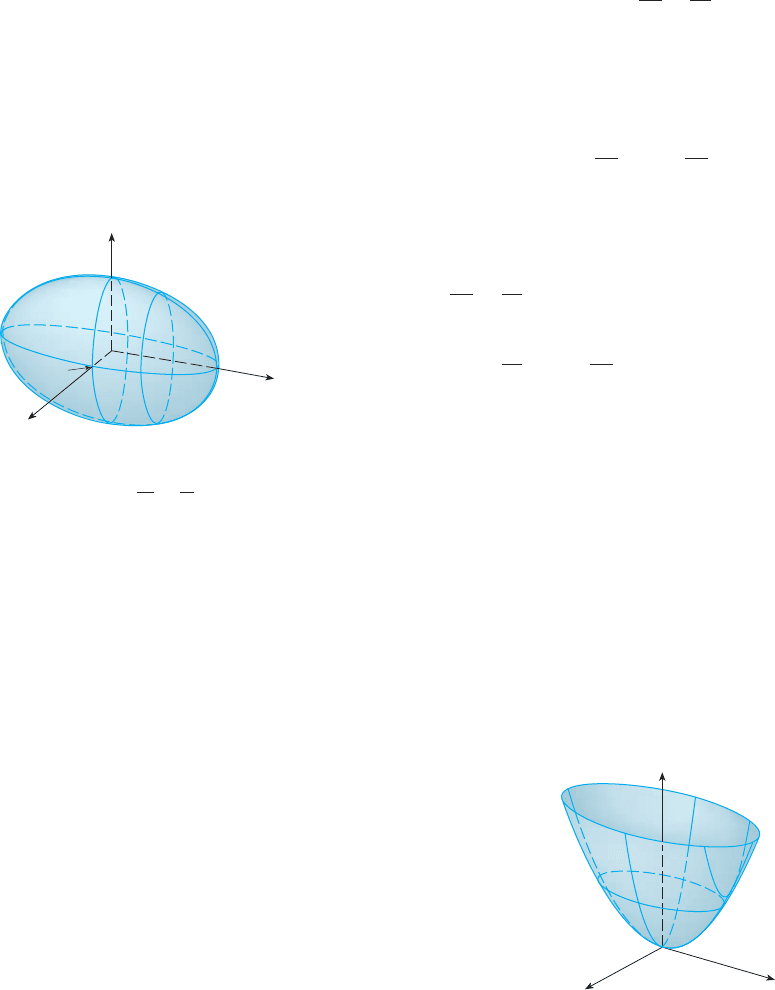
where , , are constants, but by translation and rotation it can be brought into
one of the two standard forms
or
Quadric surfaces are the counterparts in three dimensions of the conic sections in the plane.
(See Section 11.5 for a review of conic sections.)
EXAMPLE 3 Use traces to sketch the quadric surface with equation
SOLUTION By substituting , we find that the trace in the xy-plane is ,
which we recognize as an equation of an ellipse. In general, the horizontal trace in the
plane is
which is an ellipse, provided that , that is, .
Similarly, the vertical traces are also ellipses:
Figure 4 shows how drawing some traces indicates the shape of the surface. It’s called an
ellipsoid because all of its traces are ellipses. Notice that it is symmetric with respect to
each coordinate plane; this is a reflection of the fact that its equation involves only even
powers of x, y, and . M
EXAMPLE 4 Use traces to sketch the surface .
SOLUTION If we put , we get , so the -plane intersects the surface in a
parabola. If we put (a constant), we get . This means that if we
slice the graph with any plane parallel to the -plane, we obtain a parabola that opens
upward. Similarly, if , the trace is , which is again a parabola that
opens upward. If we put , we get the horizontal traces , which we
recognize as a family of ellipses. Knowing the shapes of the traces, we can sketch the
graph in Figure 5. Because of the elliptical and parabolic traces, the quadric surface
is called an elliptic paraboloid.
M
FIGURE 5
The surface z=4≈+¥ is an elliptic
paraboloid. Horizontal traces are ellipses;
vertical traces are parabolas.
x
y
0
z
z 苷 4x
2
⫹ y
2
4x
2
⫹ y
2
苷 kz 苷 k
z 苷 4x
2
⫹ k
2
y 苷 k
yz
z 苷 y
2
⫹ 4k
2
x 苷 k
yzz 苷 y
2
x 苷 0
z 苷 4x
2
⫹ y
2
z
x
2
⫹
z
2
4
苷 1 ⫺
k
2
9
y 苷 k 共if ⫺3
⬍
k
⬍
3兲
y
2
9
⫹
z
2
4
苷 1 ⫺ k
2
x 苷 k 共if ⫺1
⬍
k
⬍
1兲
⫺2
⬍
k
⬍
2k
2
⬍
4
z 苷 kx
2
⫹
y
2
9
苷 1 ⫺
k
2
4
z 苷 k
x
2
⫹ y
2
兾9 苷 1z 苷 0
x
2
⫹
y
2
9
⫹
z
2
4
苷 1
Ax
2
⫹ By
2
⫹ Iz 苷 0Ax
2
⫹ By
2
⫹ Cz
2
⫹ J 苷 0
C, ..., JBA
842
||||
CHAPTER 13 VECTORS AND THE GEOMETRY OF SPACE
FIGURE 4
The ellipsoid ≈+ + =1
z@
4
y@
9
(0,3,0)
0
(0,0,2)
(1,0,0)
x
y
z
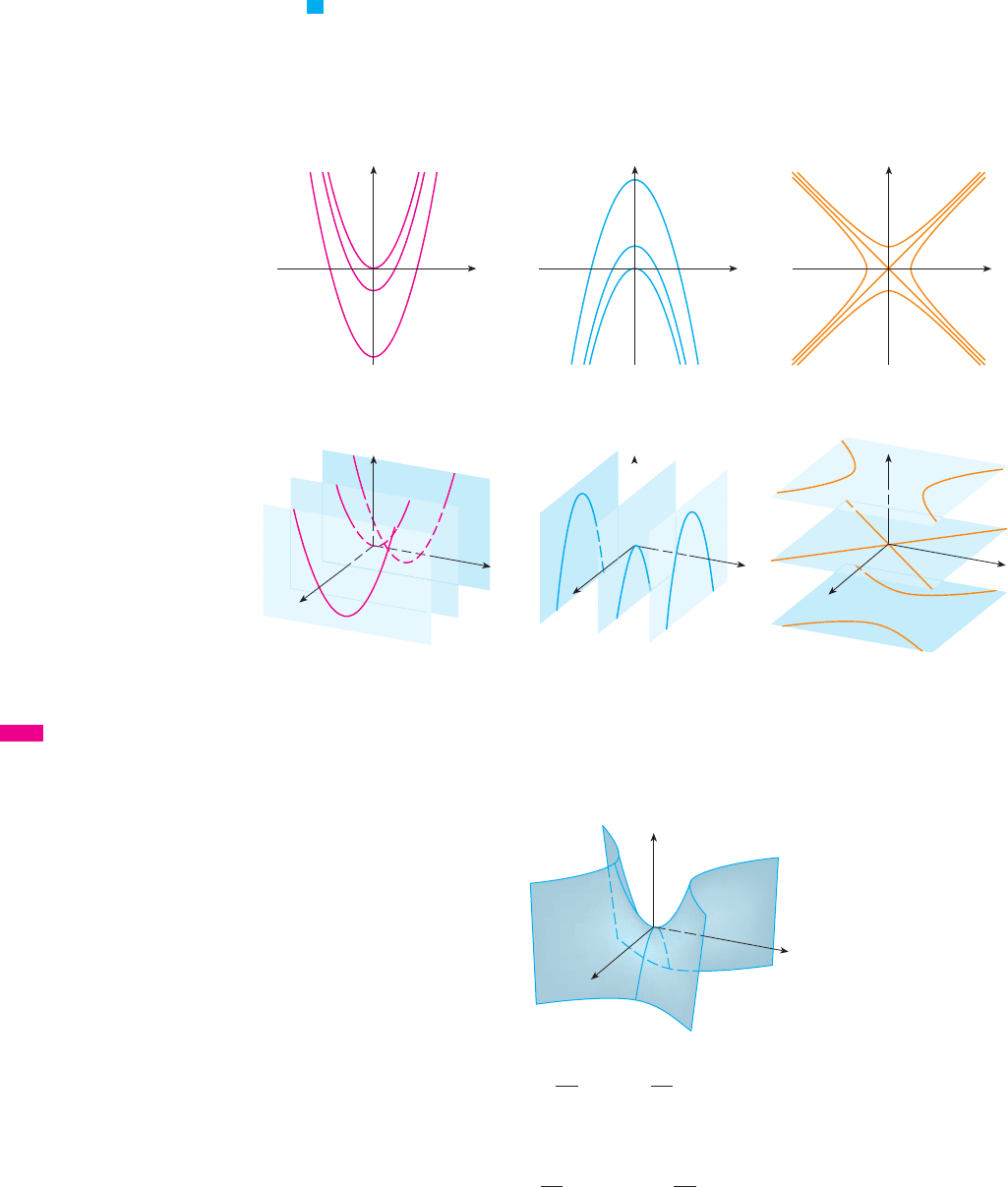
EXAMPLE 5 Sketch the surface .
SOLUTION The traces in the vertical planes are the parabolas , which
open upward. The traces in are the parabolas , which open down-
ward. The horizontal traces are , a family of hyperbolas. We draw the fami-
lies of traces in Figure 6, and we show how the traces appear when placed in their
correct planes in Figure 7.
In Figure 8 we fit together the traces from Figure 7 to form the surface ,
a hyperbolic paraboloid. Notice that the shape of the surface near the origin resembles
that of a saddle. This surface will be investigated further in Section 15.7 when we dis-
cuss saddle points.
M
EXAMPLE 6 Sketch the surface .
SOLUTION The trace in any horizontal plane is the ellipse
x
2
4
⫹ y
2
苷 1 ⫹
k
2
4
z 苷 k
z 苷 k
x
2
4
⫹ y
2
⫺
z
2
4
苷 1
x
y
0
z
FIGURE 8
The surface z=¥-≈ is a
hyperbolic paraboloid.
z 苷 y
2
⫺ x
2
FIGURE 6
Vertical traces are parabolas;
horizontal traces are hyperbolas.
All traces are labeled with the
value of k.
FIGURE 7
Traces moved to their
correct planes
Traces in x=k are z=¥-k@
0
⫾1
⫾2
Traces in z=k are ¥-≈=k
_1
1
1
0
_1
Traces in x=k
x
y
z
1
0
_1
Traces in y=k are z=_≈+k@
0
⫾1
⫾2
Traces in y=k
1
x
y
z
_1
0
Traces in z=k
x
y
z
1
0
_1
z
y
y
x
z
x
y
2
⫺ x
2
苷 k
z 苷 ⫺x
2
⫹ k
2
y 苷 k
z 苷 y
2
⫺ k
2
x 苷 k
z 苷 y
2
⫺ x
2
V
SECTION 13.6 CYLINDERS AND QUADRIC SURFACES
||||
843
In Module 13.6A you can investi-
gate how traces determine the shape of a
surface.
TEC
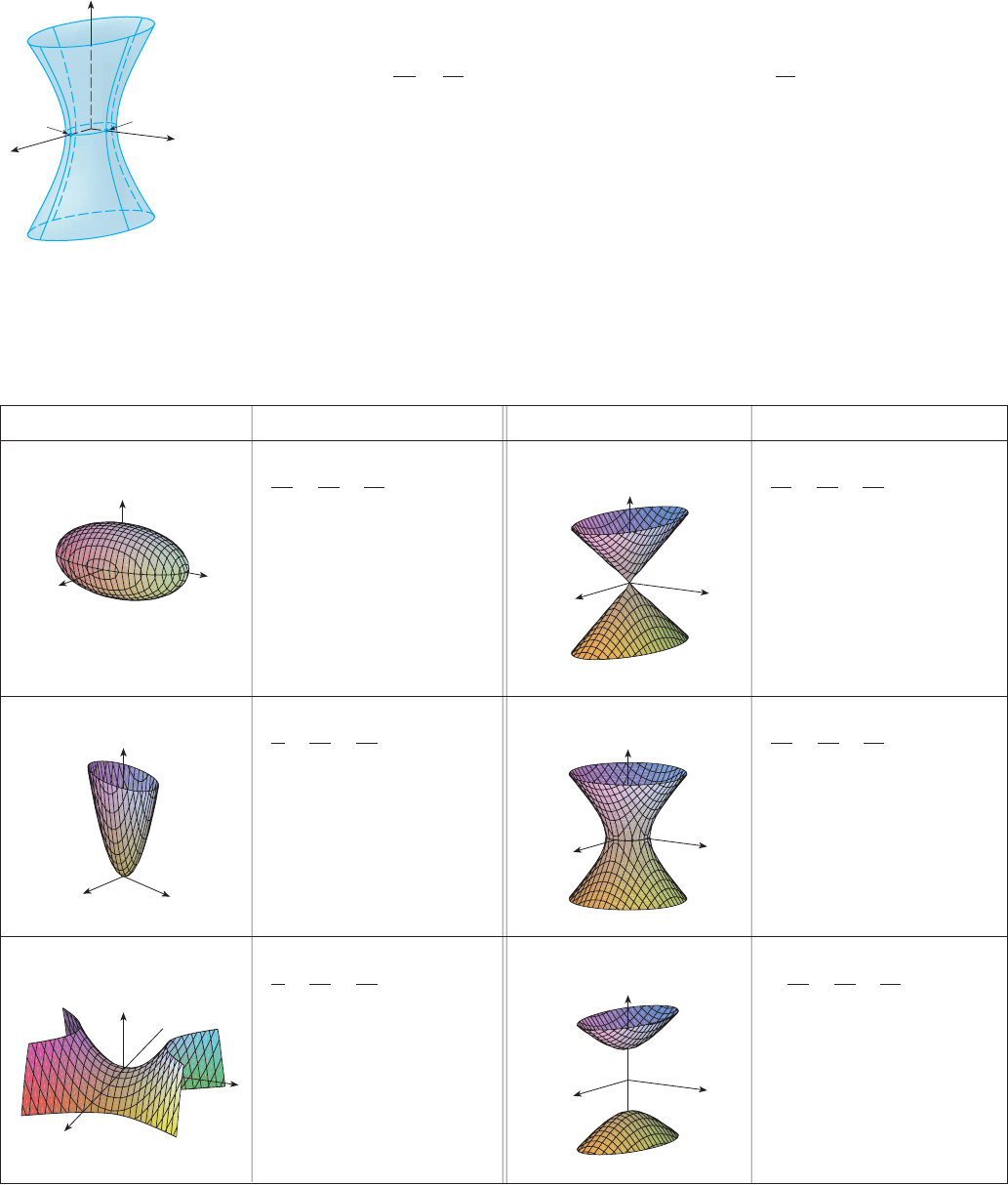
but the traces in the - and -planes are the hyperbolas
This surface is called a hyperboloid of one sheet and is sketched in Figure 9.
M
The idea of using traces to draw a surface is employed in three-dimensional graphing
software for computers. In most such software, traces in the vertical planes and
are drawn for equally spaced values of , and parts of the graph are eliminated using
hidden line removal. Table 1 shows computer-drawn graphs of the six basic types of
quadric surfaces in standard form. All surfaces are symmetric with respect to the -axis. If
a quadric surface is symmetric about a different axis, its equation changes accordingly.
z
ky 苷 k
x 苷 k
x
2
4
⫺
z
2
4
苷 1 y 苷 0andy
2
⫺
z
2
4
苷 1 x 苷 0
yzxz
844
||||
CHAPTER 13 VECTORS AND THE GEOMETRY OF SPACE
FIGURE 9
(0,1,0)
(2,0,0)
y
x
z
Surface Equation Surface Equation
Ellipsoid Cone
Elliptic Paraboloid Hyperboloid of One Sheet
Hyperbolic Paraboloid Hyperboloid of Two Sheets
z
y
x
z
y
x
z
y
x
z
y
x
z
y
x
z
y
x
Horizontal traces are ellipses.
Vertical traces in the planes
and are
hyperbolas if but are
pairs of lines if .k 苷 0
k 苷 0
y 苷 kx 苷 k
z
2
c
2
苷
x
2
a
2
⫹
y
2
b
2
All traces are ellipses.
If , the ellipsoid is
a sphere.
a 苷 b 苷 c
x
2
a
2
⫹
y
2
b
2
⫹
z
2
c
2
苷 1
Horizontal traces are ellipses.
Vertical traces are hyperbolas.
The axis of symmetry
corresponds to the variable
whose coefficient is negative.
x
2
a
2
⫹
y
2
b
2
⫺
z
2
c
2
苷 1
Horizontal traces are ellipses.
Vertical traces are parabolas.
The variable raised to the
first power indicates the axis
of the paraboloid.
z
c
苷
x
2
a
2
⫹
y
2
b
2
Horizontal traces in are
ellipses if or .
Vertical traces are hyperbolas.
The two minus signs indicate
two sheets.
k
⬍
⫺ck ⬎ c
z 苷 k
⫺
x
2
a
2
⫺
y
2
b
2
⫹
z
2
c
2
苷 1
Horizontal traces are
hyperbolas.
Vertical traces are parabolas.
The case where is
illustrated.
c
⬍
0
z
c
苷
x
2
a
2
⫺
y
2
b
2
TABLE 1 Graphs of quadric surfaces
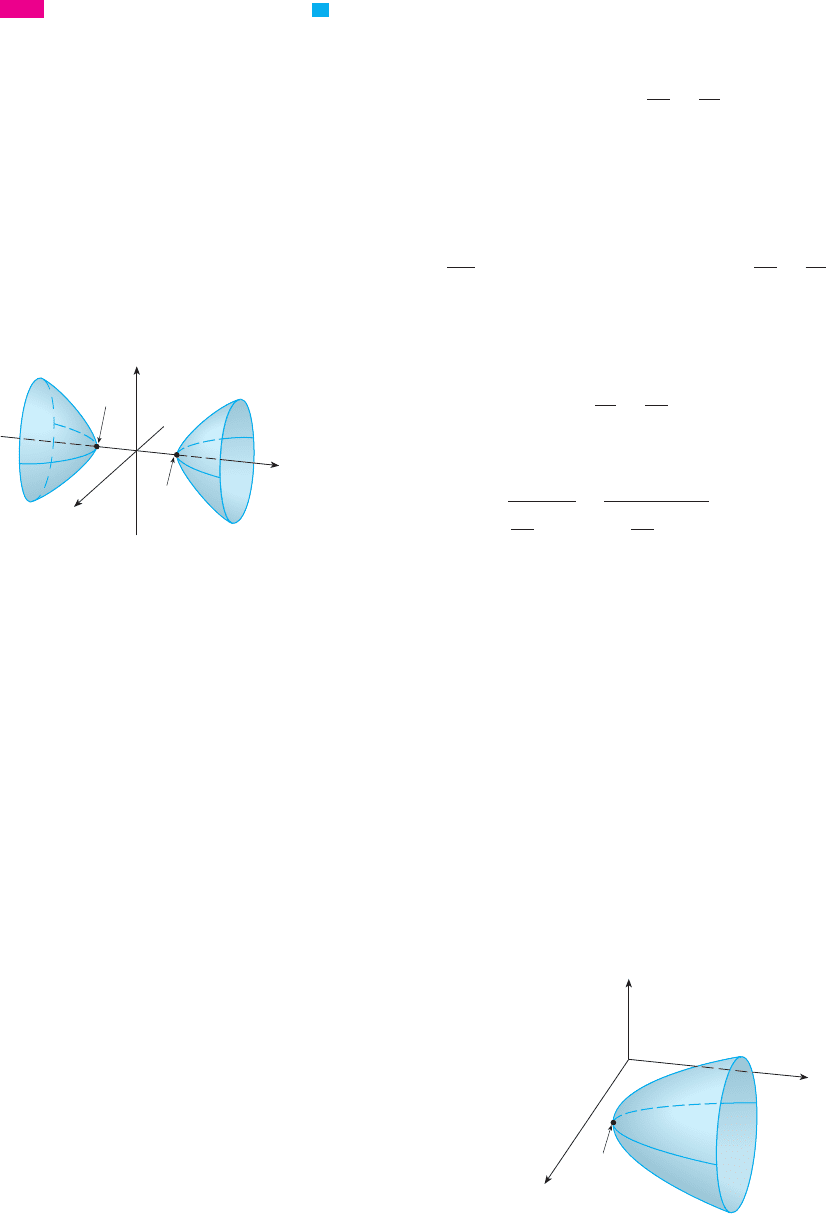
EXAMPLE 7 Identify and sketch the surface .
SOLUTION Dividing by , we first put the equation in standard form:
Comparing this equation with Table 1, we see that it represents a hyperboloid of two
sheets, the only difference being that in this case the axis of the hyperboloid is the
-axis. The traces in the - and -planes are the hyperbolas
The surface has no trace in the -plane, but traces in the vertical planes for
are the ellipses
which can be written as
These traces are used to make the sketch in Figure 10.
M
EXAMPLE 8 Classify the quadric surface .
SOLUTION By completing the square we rewrite the equation as
Comparing this equation with Table 1, we see that it represents an elliptic paraboloid.
Here, however, the axis of the paraboloid is parallel to the -axis, and it has been shifted
so that its vertex is the point . The traces in the plane are the
ellipses
The trace in the -plane is the parabola with equation , . The
paraboloid is sketched in Figure 11.
M
FIGURE 11
≈+2z@-6x-y+10=0
0
y
x
(3,1,0)
z
z 苷 0y 苷 1 ⫹ 共x ⫺ 3兲
2
xy
y 苷 k共x ⫺ 3兲
2
⫹ 2z
2
苷 k ⫺ 1
y 苷 k 共k ⬎ 1兲共3, 1, 0兲
y
y ⫺ 1 苷 共x ⫺ 3兲
2
⫹ 2z
2
x
2
⫹ 2z
2
⫺ 6x ⫺ y ⫹ 10 苷 0
y 苷 k
x
2
k
2
4
⫺ 1
⫹
z
2
2
冉
k
2
4
⫺ 1
冊
苷 1
y 苷 kx
2
⫹
z
2
2
苷
k
2
4
⫺ 1
ⱍ
k
ⱍ
⬎ 2
y 苷 kxz
x 苷 0
y
2
4
⫺
z
2
2
苷 1and z 苷 0⫺x
2
⫹
y
2
4
苷 1
yzxyy
⫺x
2
⫹
y
2
4
⫺
z
2
2
苷 1
⫺4
4x
2
⫺ y
2
⫹ 2z
2
⫹ 4 苷 0
V
SECTION 13.6 CYLINDERS AND QUADRIC SURFACES
||||
845
FIGURE 10
4≈-¥+2z@+4=0
0
z
y
x
(0,2,0)
(0,_2,0)
In Module 13.6B you can see how
changing , , and in Table 1 affects the
shape of the quadric surface.
cba
TEC
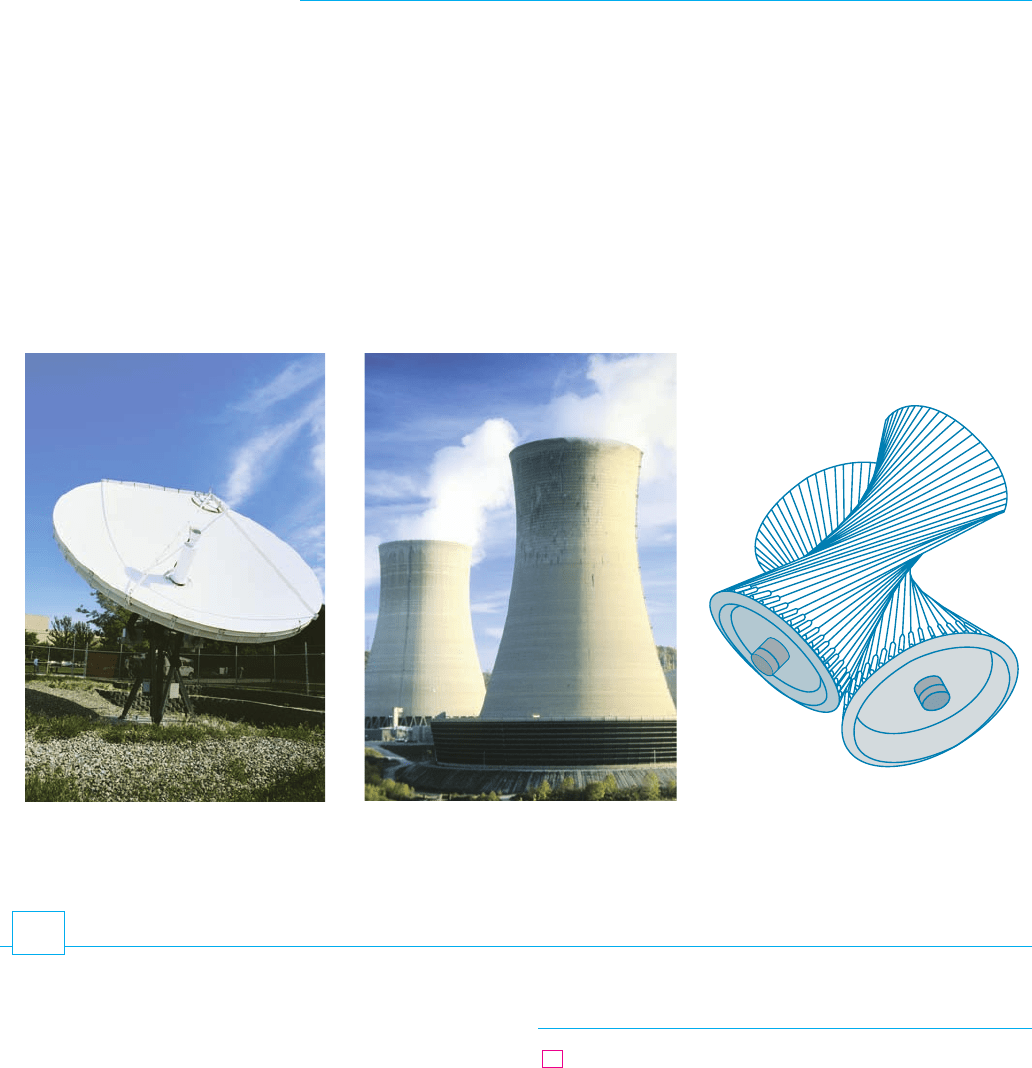
APPLICATIONS OF QUADRIC SURFACES
Examples of quadric surfaces can be found in the world around us. In fact, the world itself
is a good example. Although the earth is commonly modeled as a sphere, a more accurate
model is an ellipsoid because the earth’s rotation has caused a flattening at the poles. (See
Exercise 47.)
Circular paraboloids, obtained by rotating a parabola about its axis, are used to collect
and reflect light, sound, and radio and television signals. In a radio telescope, for instance,
signals from distant stars that strike the bowl are reflected to the receiver at the focus and
are therefore amplified. (The idea is explained in Problem 16 on page 202.) The same prin-
ciple applies to microphones and satellite dishes in the shape of paraboloids.
Cooling towers for nuclear reactors are usually designed in the shape of hyperboloids
of one sheet for reasons of structural stability. Pairs of hyperboloids are used to transmit
rotational motion between skew axes. (The cogs of gears are the generating lines of the
hyperboloids. See Exercise 49.)
846
||||
CHAPTER 13 VECTORS AND THE GEOMETRY OF SPACE
© Corbis
David Burnett / Photo Researchers, Inc
A satellite dish reflects signals to
the focus of a paraboloid.
Nuclear reactors have cooling towers
in the shape of hyperboloids.
Hyperboloids produce gear transmission.
5. 6.
7. 8.
(a) Find and identify the traces of the quadric surface
and explain why the graph looks like the
graph of the hyperboloid of one sheet in Table 1.
(b) If we change the equation in part (a) to ,
how is the graph affected?
(c) What if we change the equation in part (a) to
?x
2
⫹ y
2
⫹ 2y ⫺ z
2
苷 0
x
2
⫺ y
2
⫹ z
2
苷 1
x
2
⫹ y
2
⫺ z
2
苷 1
9.
x
2
⫺ y
2
苷 1z 苷 cos x
yz 苷 4x ⫺ y
2
苷 0
1. (a) What does the equation represent as a curve in ?
(b)
What does it represent as a surface in ?
(c) What does the equation represent?
2. (a) Sketch the graph of as a curve in .
(b) Sketch the graph of as a surface in .
(c) Describe and sketch the surface .
3–8 Describe and sketch the surface.
3. 4. z 苷 4 ⫺ x
2
y
2
⫹ 4z
2
苷 4
z 苷 e
y
⺢
3
y 苷 e
x
⺢
2
y 苷 e
x
z 苷 y
2
⺢
3
⺢
2
y 苷 x
2
EXERCISES
13.6
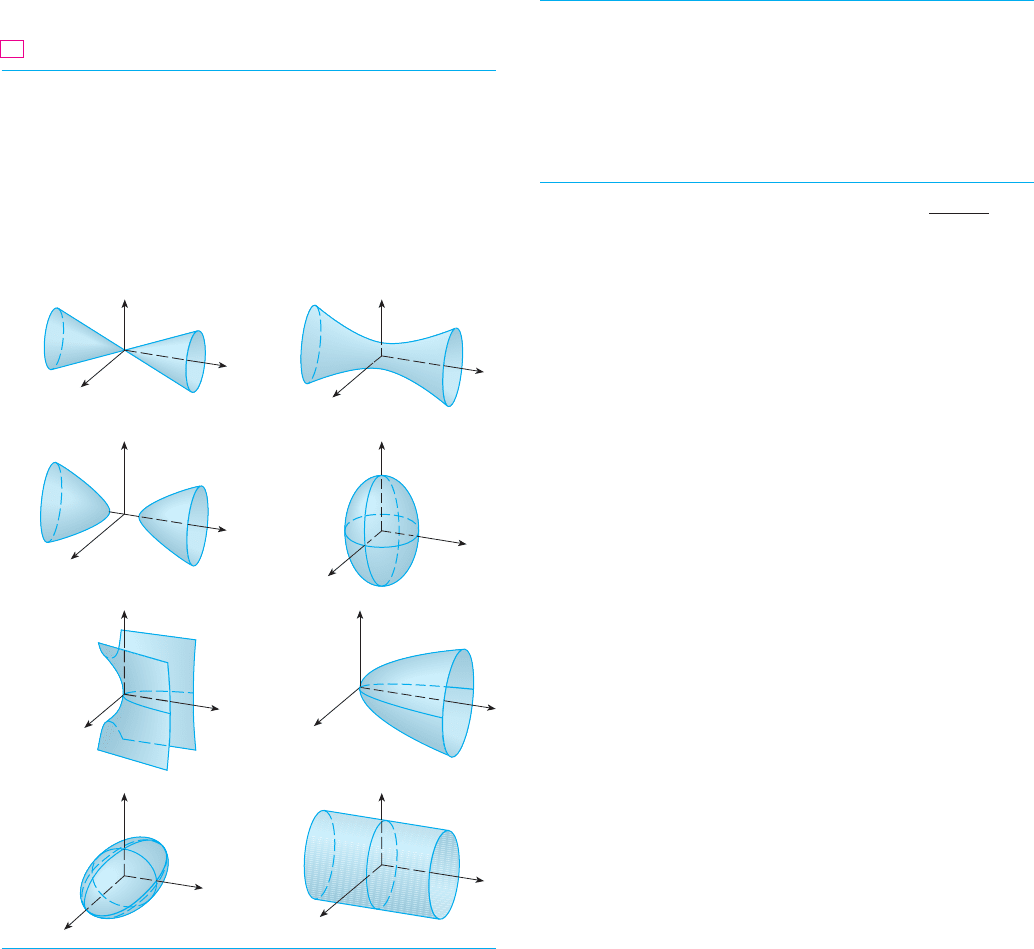
SECTION 13.6 CYLINDERS AND QUADRIC SURFACES
||||
847
29–36 Reduce the equation to one of the standard forms, classify
the surface, and sketch it.
29. 30.
31. 32.
33.
34.
35.
36.
;
37–40 Use a computer with three-dimensional graphing software
to graph the surface. Experiment with viewpoints and with domains
for the variables until you get a good view of the surface.
37. 38.
39. 40.
41. Sketch the region bounded by the surfaces
and for .
42. Sketch the region bounded by the paraboloids
and .
43. Find an equation for the surface obtained by rotating the
parabola about the -axis.
44. Find an equation for the surface obtained by rotating the line
about the -axis.
45. Find an equation for the surface consisting of all points that
are equidistant from the point and the plane .
Identify the surface.
46. Find an equation for the surface consisting of all points for
which the distance from to the -axis is twice the distance
from to the -plane. Identify the surface.
47. Traditionally, the earth’s surface has been modeled as a sphere,
but the World Geodetic System of 1984 (WGS-84) uses an
ellipsoid as a more accurate model. It places the center of the
earth at the origin and the north pole on the positive -axis.
The distance from the center to the poles is 6356.523 km and
the distance to a point on the equator is 6378.137 km.
(a) Find an equation of the earth’s surface as used by
WGS-84.
(b) Curves of equal latitude are traces in the planes .
What is the shape of these curves?
(c) Meridians (curves of equal longitude) are traces in
planes of the form . What is the shape of these
meridians?
48. A cooling tower for a nuclear reactor is to be constructed in
the shape of a hyperboloid of one sheet (see the photo on
page 846). The diameter at the base is 280 m and the minimum
y 苷 mx
z 苷 k
z
yzP
xP
P
x 苷 1共⫺1, 0, 0兲
xx 苷 3y
yy 苷 x
2
z 苷 2 ⫺ x
2
⫺ y
2
z 苷 x
2
⫹ y
2
1 艋 z 艋 2x
2
⫹ y
2
苷 1
z 苷
s
x
2
⫹ y
2
x
2
⫺ 6x ⫹ 4y
2
⫺ z 苷 0⫺4x
2
⫺ y
2
⫹ z
2
苷 0
x
2
⫺ y
2
⫺ z 苷 0⫺4x
2
⫺ y
2
⫹ z
2
苷 1
x
2
⫺ y
2
⫹ z
2
⫺ 2x ⫹ 2y ⫹ 4z ⫹ 2 苷 0
x
2
⫺ y
2
⫹ z
2
⫺ 4x ⫺ 2y ⫺ 2z ⫹ 4 苷 0
4y
2
⫹ z
2
⫺ x ⫺ 16y ⫺ 4z ⫹ 20 苷 0
4x
2
⫹ y
2
⫹ 4z
2
⫺ 4y ⫺ 24z ⫹ 36 苷 0
4x ⫺ y
2
⫹ 4z
2
苷 0x 苷 2y
2
⫹ 3z
2
x
2
苷 2y
2
⫹ 3z
2
z
2
苷 4x
2
⫹ 9y
2
⫹ 36
10. (a) Find and identify the traces of the quadric surface
and explain why the graph looks like
the graph of the hyperboloid of two sheets in Table 1.
(b) If the equation in part (a) is changed to ,
what happens to the graph? Sketch the new graph.
11– 20 Use traces to sketch and identify the surface.
11. 12.
13. 14.
15. 16.
17. 18.
20.
21– 28 Match the equation with its graph (labeled I–VIII). Give
reasons for your choices.
21. 22.
23. 24.
25. 26.
27. 28.
y 苷 x
2
⫺ z
2
x
2
⫹ 2z
2
苷 1
y
2
苷 x
2
⫹ 2z
2
y 苷 2x
2
⫹ z
2
⫺x
2
⫹ y
2
⫺ z
2
苷 1x
2
⫺ y
2
⫹ z
2
苷 1
9x
2
⫹ 4y
2
⫹ z
2
苷 1x
2
⫹ 4y
2
⫹ 9z
2
苷 1
x 苷 y
2
⫺ z
2
y 苷 z
2
⫺ x
2
19.
4x
2
⫺ 16y
2
⫹ z
2
苷 1636x
2
⫹ y
2
⫹ 36z
2
苷 36
4x
2
⫹ 9y
2
⫹ z 苷 0⫺x
2
⫹ 4y
2
⫺ z
2
苷 4
25x
2
⫹ 4y
2
⫹ z
2
苷 100x
2
苷 y
2
⫹ 4z
2
9x
2
⫺ y
2
⫹ z
2
苷 0x 苷 y
2
⫹ 4z
2
x
2
⫺ y
2
⫺ z
2
苷 1
⫺x
2
⫺ y
2
⫹ z
2
苷 1
I
III
V
z
y
x
z
y
x
z
y
x
z
y
x
z
y
x
z
y
x
z
y
x
z
y
x
II
IV
VI
VII
VIII
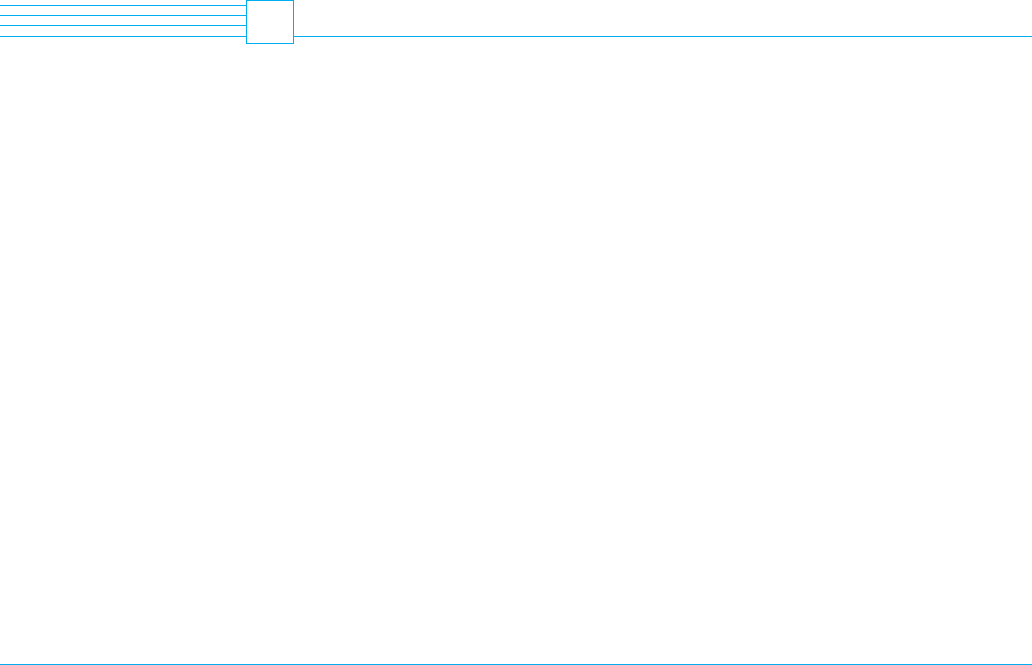
generating lines. The only other quadric surfaces that are ruled
surfaces are cylinders, cones, and hyperboloids of one sheet.)
50. Show that the curve of intersection of the surfaces
and
lies in a plane.
;
51. Graph the surfaces and on a common
screen using the domain , and observe the
curve of intersection of these surfaces. Show that the projection
of this curve onto the -plane is an ellipse.xy
ⱍ
y
ⱍ
艋 1.2
ⱍ
x
ⱍ
艋 1.2
z 苷 1 ⫺ y
2
z 苷 x
2
⫹ y
2
2x
2
⫹ 4y
2
⫺ 2z
2
⫺ 5y 苷 0x
2
⫹ 2y
2
⫺ z
2
⫹ 3x 苷 1
diameter, 500 m above the base, is 200 m. Find an equation
for the tower.
49. Show that if the point lies on the hyperbolic paraboloid
, then the lines with parametric equations
, , and ,
, both lie entirely on this parabo-
loid. (This shows that the hyperbolic paraboloid is what is
called a ruled surface; that is, it can be generated by the
motion of a straight line. In fact, this exercise shows that
through each point on the hyperbolic paraboloid there are two
z 苷 c ⫺ 2共b ⫹ a兲ty 苷 b ⫺ t
x 苷 a ⫹ tz 苷 c ⫹ 2共b ⫺ a兲ty 苷 b ⫹ tx 苷 a ⫹ t
z 苷 y
2
⫺ x
2
共a, b, c兲
848
||||
CHAPTER 13 VECTORS AND THE GEOMETRY OF SPACE
REVIEW
CONCEPT CHECK
13
11. How do you find a vector perpendicular to a plane?
12. How do you find the angle between two intersecting planes?
13. Write a vector equation, parametric equations, and symmetric
equations for a line.
14. Write a vector equation and a scalar equation for a plane.
15. (a) How do you tell if two vectors are parallel?
(b) How do you tell if two vectors are perpendicular?
(c) How do you tell if two planes are parallel?
16. (a) Describe a method for determining whether three points
, , and lie on the same line.
(b) Describe a method for determining whether four points
, , , and lie in the same plane.
17. (a) How do you find the distance from a point to a line?
(b) How do you find the distance from a point to a plane?
(c) How do you find the distance between two lines?
18. What are the traces of a surface? How do you find them?
19. Write equations in standard form of the six types of quadric
surfaces.
SRQP
RQP
1. What is the difference between a vector and a scalar?
2. How do you add two vectors geometrically? How do you add
them algebraically?
3. If a is a vector and c is a scalar, how is ca related to a
geometrically? How do you find ca algebraically?
4. How do you find the vector from one point to another?
5. How do you find the dot product of two vectors if you
know their lengths and the angle between them? What if you
know their components?
6. How are dot products useful?
7. Write expressions for the scalar and vector projections of b
onto a. Illustrate with diagrams.
8. How do you find the cross product a ⫻ b of two vectors if you
know their lengths and the angle between them? What if you
know their components?
9. How are cross products useful?
10. (a) How do you find the area of the parallelogram determined
by a and b?
(b) How do you find the volume of the parallelepiped
determined by a, b, and c?
a ⴢ b
Determine whether the statement is true or false. If it is true, explain why.
If it is false, explain why or give an example that disproves the statement.
1. For any vectors and in , .
2. For any vectors and in , .
3. For any vectors and in , .
4. For any vectors and in and any scalar ,
.
5. For any vectors and in and any scalar ,
.k共u ⫻ v兲 苷 共k u兲 ⫻ v
kV
3
vu
k共u ⴢ v兲 苷 共k u兲 ⴢ v
kV
3
vu
ⱍ
u ⫻ v
ⱍ
苷
ⱍ
v ⫻ u
ⱍ
V
3
vu
u ⫻ v 苷 v ⫻ uV
3
vu
u ⴢ v 苷 v ⴢ uV
3
vu
6. For any vectors , , and in ,
.
7. For any vectors , , and in ,
.
8. For any vectors , , and in ,
.
9. For any vectors and in , .
10. For any vectors and in , .共u ⫹ v兲 ⫻ v 苷 u ⫻ vV
3
vu
共u ⫻ v兲 ⴢ u 苷 0V
3
vu
u ⫻ 共v ⫻ w兲 苷 共u ⫻ v兲 ⫻ w
V
3
wvu
u ⴢ 共v ⫻ w兲 苷 共u ⫻ v兲 ⴢ w
V
3
wvu
共u ⫹ v兲 ⫻ w 苷 u ⫻ w ⫹ v ⫻ w
V
3
wvu
TRUE-FALSE QUIZ
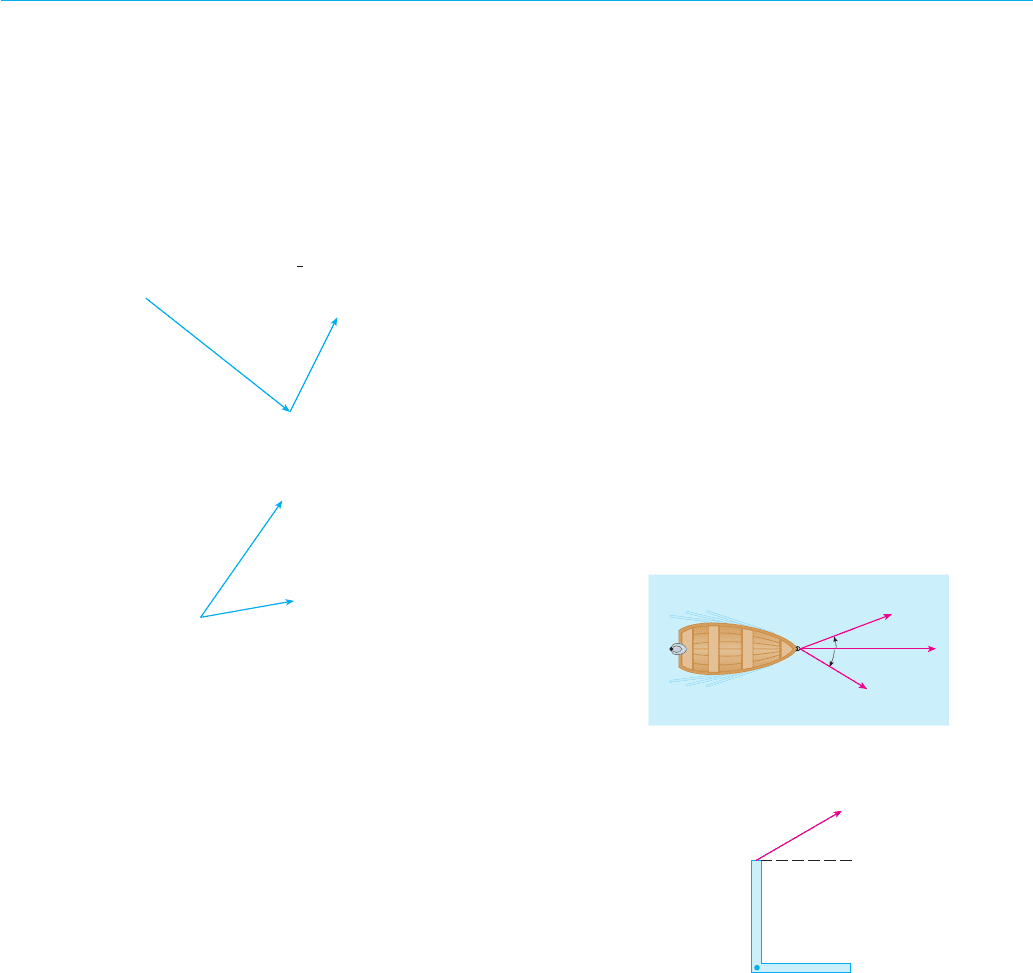
CHAPTER 13 REVIEW
||||
849
15. If , then or .
16. If , then or .
17. If , and , then or .
18. If and are in , then .
ⱍ
u ⴢ v
ⱍ
艋
ⱍ
u
ⱍ
ⱍ
v
ⱍ
V
3
vu
v 苷 0u 苷 0u ⫻ v 苷 0u ⴢ v 苷 0
v 苷 0u 苷 0u ⫻ v 苷 0
v 苷 0u 苷 0u ⴢ v 苷 0
11. The cross product of two unit vectors is a unit vector.
12. A linear equation represents a line
in space.
13. The set of points is a circle.
14. If and , then .u ⴢ v 苷 具u
1
v
1
, u
2
v
2
典v 苷 具v
1
, v
2
典u 苷 具u
1
, u
2
典
{
共x, y, z兲
ⱍ
x
2
⫹ y
2
苷 1
}
Ax ⫹ By ⫹ Cz ⫹ D 苷 0
1. (a) Find an equation of the sphere that passes through the point
and has center .
(b) Find the curve in which this sphere intersects the
-plane.
(c) Find the center and radius of the sphere
2. Copy the vectors in the figure and use them to draw each of the
following vectors.
(a) (b) (c) (d)
3. If u and v are the vectors shown in the figure, find and
. Is u ⫻ v directed into the page or out of it?
4. Calculate the given quantity if
(a) (b)
(c) (d)
(e) (f)
(g) (h)
(i) (j)
(k) The angle between and (correct to the nearest degree)
5. Find the values of such that the vectors and
are orthogonal.
6. Find two unit vectors that are orthogonal to both
and .i ⫺ 2j ⫹ 3k
j ⫹ 2k
具2x, 4, x典
具3, 2, x 典x
ba
proj
a
bcomp
a
b
a ⫻ 共b ⫻ c兲c ⫻ c
a ⴢ 共b ⫻ c兲
ⱍ
b ⫻ c
ⱍ
a ⫻ ba ⴢ b
ⱍ
b
ⱍ
2a ⫹ 3b
c 苷 j ⫺ 5kb 苷 3i ⫺ 2j ⫹ ka 苷 i ⫹ j ⫺ 2k
45°
|v |=
3
|
u
|=
2
ⱍ
u ⫻ v
ⱍ
u ⴢ v
a
b
2a ⫹ b⫺
1
2
aa ⫺ ba ⫹ b
x
2
⫹ y
2
⫹ z
2
⫺ 8x ⫹ 2y ⫹ 6z ⫹ 1 苷 0
yz
共⫺1, 2, 1兲共6, ⫺2, 3兲
7. Suppose that . Find
(a) (b)
(c) (d)
8. Show that if , , and are in , then
9. Find the acute angle between two diagonals of a cube.
10. Given the points , , , and
, find the volume of the parallelepiped with adjacent
edges , , and .
11. (a) Find a vector perpendicular to the plane through the points
, , and .
(b) Find the area of triangle .
12. A constant force moves an object along
the line segment from to . Find the work done
if the distance is measured in meters and the force in newtons.
13. A boat is pulled onto shore using two ropes, as shown in the
diagram. If a force of 255 N is needed, find the magnitude of
the force in each rope.
14. Find the magnitude of the torque about if a 50-N force is
applied as shown.
P
40 cm
50 N
30°
P
20°
30°
255 N
共5, 3, 8兲共1, 0, 2兲
F 苷 3i ⫹ 5j ⫹ 10k
ABC
C共1, 4, 3兲B共2, 0, ⫺1兲A共1, 0, 0兲
ADACAB
D共0, 3, 2兲
C共⫺1, 1, 4兲B共2, 3, 0兲A共1, 0, 1兲
共a ⫻ b兲 ⴢ 关共b ⫻ c兲 ⫻ 共c ⫻ a兲兴 苷 关a ⴢ 共b ⫻ c兲兴
2
V
3
cba
共u ⫻ v兲 ⴢ vv ⴢ 共u ⫻ w兲
u ⴢ 共w ⫻ v兲共u ⫻ v兲 ⴢ w
u ⴢ 共v ⫻ w兲 苷 2
EXERCISES

850
||||
CHAPTER 13 VECTORS AND THE GEOMETRY OF SPACE
(b) Find, correct to the nearest degree, the angle between these
planes.
25. Find an equation of the plane through the line of intersection of
the planes and and perpendicular to the
plane .
26. (a) Find an equation of the plane that passes through the points
, , and .
(b) Find symmetric equations for the line through that is
perpendicular to the plane in part (a).
(c) A second plane passes through and has normal
vector . Show that the acute angle between the
planes is approximately .
(d) Find parametric equations for the line of intersection of the
two planes.
27. Find the distance between the planes
and .
28–36 Identify and sketch the graph of each surface.
28. 29.
30. 31.
32. 33.
34.
35.
36.
37. An ellipsoid is created by rotating the ellipse
about the -axis. Find an equation of the ellipsoid.
38. A surface consists of all points such that the distance from
to the plane is twice the distance from to the point
. Find an equation for this surface and identify it.共0, ⫺1, 0兲
Py 苷 1
PP
x
4x
2
⫹ y
2
苷 16
x 苷 y
2
⫹ z
2
⫺ 2y ⫺ 4z ⫹ 5
4x
2
⫹ 4y
2
⫺ 8y ⫹ z
2
苷 0
y
2
⫹ z
2
苷 1 ⫹ x
2
⫺4x
2
⫹ y
2
⫺ 4z
2
苷 44x ⫺ y ⫹ 2z 苷 4
x
2
苷 y
2
⫹ 4z
2
y 苷 z
2
x 苷 zx 苷 3
3x ⫹ y ⫺ 4z 苷 24
3x ⫹ y ⫺ 4z 苷 2
43⬚
具2, ⫺4, ⫺3典
共2, 0, 4兲
B
C共1, 3, ⫺4兲B共⫺1, ⫺1, 10兲A共2, 1, 1兲
x ⫹ y ⫺ 2z 苷 1
y ⫹ 2z 苷 3x ⫺ z 苷 1
15–17 Find parametric equations for the line.
15. The line through and
16. The line through and parallel to the line
17. The line through and perpendicular to the
plane
18–20 Find an equation of the plane.
18. The plane through and parallel to
19. The plane through , , and
20. The plane through that contains the line
, ,
21. Find the point in which the line with parametric equations
, , intersects the plane
.
22. Find the distance from the origin to the line
, , .
23. Determine whether the lines given by the symmetric
equations
and
are parallel, skew, or intersecting.
24. (a) Show that the planes and
are neither parallel nor perpendicular.2x ⫺ 3y ⫹ 4z 苷 5
x ⫹ y ⫺ z 苷 1
x ⫹ 1
6
苷
y ⫺ 3
⫺1
苷
z ⫹ 5
2
x ⫺ 1
2
苷
y ⫺ 2
3
苷
z ⫺ 3
4
z 苷 ⫺1 ⫹ 2ty 苷 2 ⫺ tx 苷 1 ⫹ t
2x ⫺ y ⫹ z 苷 2
z 苷 4ty 苷 1 ⫹ 3tx 苷 2 ⫺ t
z 苷 1 ⫹ 3ty 苷 3 ⫺ tx 苷 2t
共1, 2, ⫺2兲
共6, 3, 1兲共4, 0, 2兲共3, ⫺1, 1兲
x ⫹ 4y ⫺ 3z 苷 1共2, 1, 0兲
2x ⫺ y ⫹ 5z 苷 12
共⫺2, 2, 4兲
1
3
共x ⫺ 4兲 苷
1
2
y 苷 z ⫹ 2
共1, 0, ⫺1兲
共1, 1, 5兲共4, ⫺1, 2兲
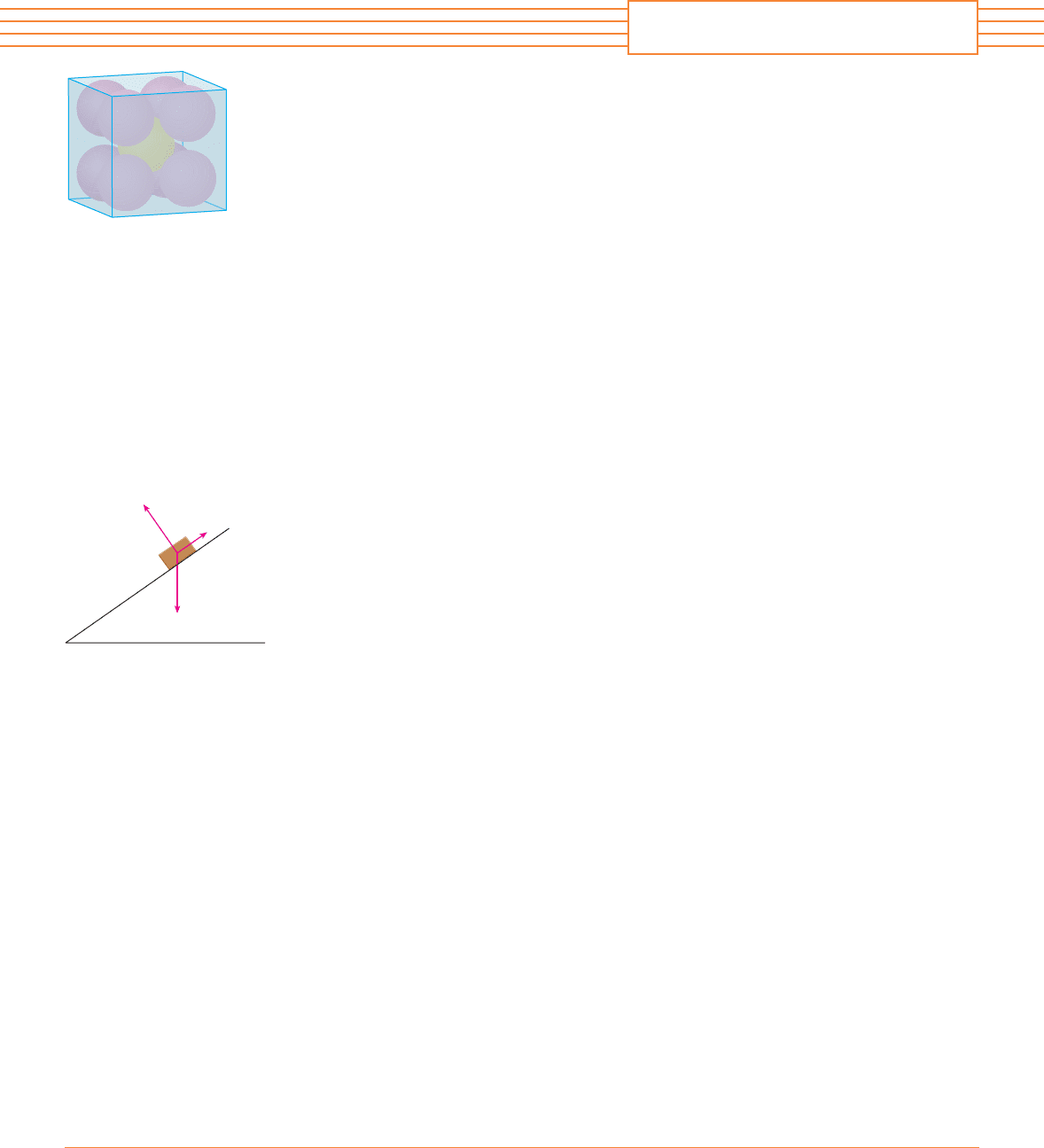
851
1. Each edge of a cubical box has length 1 m. The box contains nine spherical balls with the
same radius . The center of one ball is at the center of the cube and it touches the other eight
balls. Each of the other eight balls touches three sides of the box. Thus the balls are tightly
packed in the box. (See the figure.) Find . (If you have trouble with this problem, read about
the problem-solving strategy entitled Use Analogy on page 54.)
2. Let be a solid box with length , width , and height . Let be the set of all points that
are a distance at most 1 from some point of . Express the volume of in terms of , ,
and .
3. Let be the line of intersection of the planes and ,
where is a real number.
(a) Find symmetric equations for .
(b) As the number varies, the line sweeps out a surface . Find an equation for the curve
of intersection of with the horizontal plane (the trace of in the plane ).
(c) Find the volume of the solid bounded by and the planes and .
4. A plane is capable of flying at a speed of 180 km兾h in still air. The pilot takes off from an
airfield and heads due north according to the plane’s compass. After 30 minutes of flight time,
the pilot notices that, due to the wind, the plane has actually traveled 80 km at an angle 5° east
of north.
(a) What is the wind velocity?
(b) In what direction should the pilot have headed to reach the intended destination?
5. Suppose a block of mass is placed on an inclined plane, as shown in the figure. The block’s
descent down the plane is slowed by friction; if is not too large, friction will prevent the
block from moving at all. The forces acting on the block are the weight , where
( is the acceleration due to gravity); the normal force (the normal component of the reac-
tionary force of the plane on the block), where ; and the force F due to friction,
which acts parallel to the inclined plane, opposing the direction of motion. If the block is at
rest and is increased, must also increase until ultimately reaches its maximum,
beyond which the block begins to slide. At this angle , it has been observed that is
proportional to . Thus, when is maximal, we can say that , where is
called the coefficient of static friction and depends on the materials that are in contact.
(a) Observe that N ⫹ F ⫹ W ⫽ 0 and deduce that .
(b) Suppose that, for , an additional outside force is applied to the block, horizontally
from the left, and let . If is small, the block may still slide down the plane; if
is large enough, the block will move up the plane. Let be the smallest value of that
allows the block to remain motionless (so that is maximal).
By choosing the coordinate axes so that lies along the -axis, resolve each force into
components parallel and perpendicular to the inclined plane and show that
and
(c) Show that
Does this equation seem reasonable? Does it make sense for ? As ?
Explain.
(d) Let be the largest value of that allows the block to remain motionless. (In which
direction is heading?) Show that
Does this equation seem reasonable? Explain.
h
max
苷 m t tan共
⫹
s
兲
F
hh
max
l 90⬚
苷
s
h
min
苷 m t tan共
⫺
s
兲
h
min
cos
⫹
s
n 苷 mt sin
h
min
sin
⫹ m t cos
苷 n
xF
ⱍ
F
ⱍ
hh
min
hh
ⱍ
H
ⱍ
苷 h
H
⬎
s
s
苷 tan共
s
兲
s
ⱍ
F
ⱍ
苷
s
n
ⱍ
F
ⱍ
n
ⱍ
F
ⱍ
s
ⱍ
F
ⱍⱍ
F
ⱍ
ⱍ
N
ⱍ
苷 n
Nt
ⱍ
W
ⱍ
苷 mtW
m
z 苷 1z 苷 0S
z 苷 tSz 苷 tS
SLc
L
c
x ⫺ cy ⫹ cz 苷 ⫺1cx ⫹ y ⫹ z 苷 cL
H
WLSB
SHWLB
r
r
PROBLEMS PLUS
1 m
1 m
1 m
1m
FIGURE FOR PROBLEM 1
N
F
W
FIGURE FOR PROBLEM 5
¨
